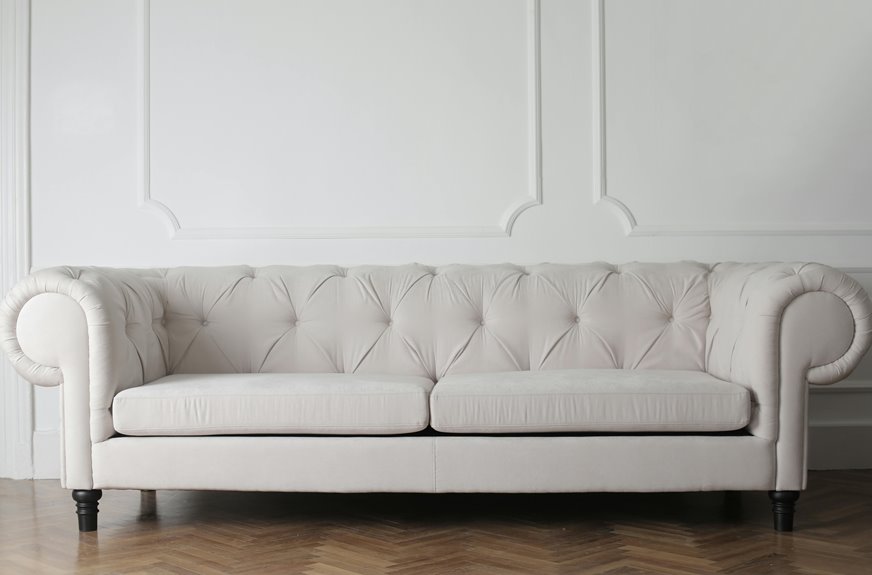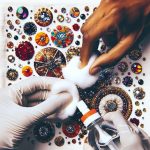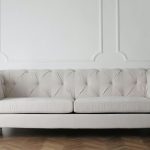Your faux leather sofa is peeling because its synthetic coating wears down due to heat, sunlight, moisture, and harsh cleaning products, exposing the fabric underneath and causing damage. Low-quality materials or poor construction can make peeling worse. To fix it, gently clean the area, apply a repair kit, and use matching paint or conditioner. Taking preventative steps like keeping it out of direct sun and cleaning carefully helps too. Keep exploring to discover effective repair and care tips that extend your sofa’s life.
Table of Contents
Key Takeaways
- Faux leather peeling often results from low-quality materials or thin coatings that wear off quickly, exposing the fabric underneath.
- Prolonged sunlight, heat, and humidity degrade faux leather, causing brittleness, cracking, and peeling over time.
- Harsh cleaning chemicals or abrasive scrubbing can damage the protective layer, accelerating peeling and surface deterioration.
- Repair peeling by cleaning gently, using a faux leather repair kit, and applying matching paint to blend the patch.
- Prevent peeling by regular cleaning with mild soap, avoiding direct sunlight, and conditioning faux leather every few months.
Understanding Faux Leather Material
Faux leather, also known as synthetic leather, mimics the look and feel of real leather but is made from plastic-based materials like polyurethane or polyvinyl chloride.
When you choose a faux leather sofa, you’re getting a surface that’s designed to be more affordable and easier to maintain than genuine leather.
However, these materials have a thin, flexible coating applied to a fabric backing, which can wear down over time.
Unlike real leather, faux leather doesn’t develop a natural patina or age gracefully.
It’s important to understand that the plastic layers can be sensitive to heat, sunlight, and abrasion.
Knowing how faux leather is constructed helps you handle your sofa with care and anticipate potential issues before they become serious problems.
Common Causes of Peeling on Faux Leather Sofas
You’ll often find that peeling starts because the faux leather is made from low-quality materials that can’t hold up over time.
Environmental factors like sunlight, heat, and humidity also play a big role in breaking down the surface.
Understanding these causes can help you prevent further damage to your sofa.
Material Quality Issues
Because the quality of materials directly affects durability, low-grade synthetic leather often peels quickly. If your faux leather sofa is shedding its surface, poor material quality might be the culprit.
Here’s what to watch out for:
- Thin Coating – Cheaper faux leather uses a thin polyurethane layer that wears off easily with regular use.
- Inferior Base Fabric – A weak fabric backing can’t support the surface, causing it to crack and peel.
- Substandard Manufacturing – Flaws in bonding or curing during production lead to early deterioration.
When shopping for a replacement or repair, prioritize sofas made with higher-grade materials and better construction. This helps guarantee your sofa stays intact and looks good longer.
Environmental Damage Effects
Material quality plays a big role in how long your sofa’s surface lasts, but even the best-made faux leather can suffer when exposed to harsh environmental conditions.
If your sofa sits in direct sunlight, UV rays can break down the synthetic coating, causing it to dry out, crack, and peel. Likewise, extreme temperatures—whether too hot or too cold—can weaken the material’s flexibility and lead to flaking.
High humidity or excessive moisture encourages mold and mildew growth, which damages the surface and accelerates peeling.
To protect your faux leather sofa, avoid placing it near windows with intense sunlight or heating vents. Using curtains or blinds and maintaining a stable indoor climate helps preserve the material’s integrity and prevents environmental damage from causing peeling.
The Role of Sunlight and Heat in Damage
Although faux leather offers a stylish and affordable alternative to genuine leather, it can’t withstand prolonged exposure to sunlight and heat without suffering damage.
Faux leather is stylish and affordable but vulnerable to damage from extended sunlight and heat exposure.
When your sofa sits in direct sunlight or near heat sources, the material breaks down faster, leading to peeling and cracking.
Here’s how sunlight and heat harm your faux leather:
- UV rays degrade the surface, causing fading and weakening the protective layer.
- Heat dries out the synthetic material, making it brittle and prone to cracking.
- Temperature fluctuations cause the material to expand and contract, accelerating wear.
To protect your sofa, keep it away from windows with strong sunlight and avoid placing it near radiators or heating vents.
This simple step can extend your sofa’s life and keep it looking fresh.
Effects of Cleaning Products on Faux Leather
If you use the wrong cleaning products on your faux leather sofa, you risk accelerating peeling and damage. Harsh chemicals like bleach, ammonia, or strong detergents can break down the protective coating, causing it to crack and flake.
Even some household cleaners labeled “safe for leather” might contain ingredients that aren’t suitable for faux leather. Instead, opt for mild soap mixed with water or cleaners specifically designed for synthetic materials.
Always test any product on a hidden area first to verify it doesn’t cause discoloration or deterioration. Avoid abrasive scrubbing tools; a soft cloth works best.
How Humidity and Moisture Contribute to Peeling
You mightn’t realize it, but high humidity can weaken your faux leather and cause it to peel.
Moisture often gets trapped, creating damp spots that speed up damage.
To protect your sofa, you’ll want to control humidity and keep it dry.
Effects of High Humidity
When high humidity lingers in your home, it creates a moist environment that weakens the adhesive bond in your faux leather sofa. This moisture causes the materials to swell and lose their grip, leading to peeling over time.
Here’s how high humidity affects your sofa:
- Material Breakdown: Excess moisture softens the faux leather’s surface, making it more prone to cracking and peeling.
- Adhesive Failure: The glue holding layers together weakens, causing the top layer to separate and flake off.
- Mold Growth: Persistent humidity can encourage mold, which deteriorates the fabric and contributes to damage.
To protect your sofa, controlling indoor humidity is essential. Use dehumidifiers or air conditioners to maintain a dry environment and extend your sofa’s lifespan.
Moisture Trapping Problems
High humidity doesn’t just weaken adhesives; it also creates pockets where moisture gets trapped within your faux leather sofa.
When moisture accumulates beneath the surface, it causes the material to swell and lose its flexibility. This trapped dampness leads to bubbling and eventually causes the outer layer to peel away. You mightn’t notice this moisture buildup right away, but it slowly breaks down the bonding agents holding the layers together.
Additionally, trapped moisture promotes mold growth, which further damages the faux leather and weakens its structure. If you don’t address this issue, peeling will worsen over time, shortening your sofa’s lifespan.
Understanding how moisture gets trapped helps you recognize why peeling happens and highlights the importance of managing humidity levels around your furniture.
Preventing Dampness Damage
Controlling humidity and moisture is key to preventing your faux leather sofa from peeling. When dampness lingers, it weakens the material and causes the surface to crack and flake.
To protect your sofa, follow these steps:
- Use a dehumidifier in rooms prone to high humidity to keep moisture levels in check.
- Avoid placing your sofa near windows or walls where condensation forms frequently.
- Regularly air out your living space to improve ventilation and reduce trapped moisture.
Step-by-Step Guide to Repairing Peeling Faux Leather
Although peeling faux leather can seem discouraging, you can restore your sofa’s appearance with a few simple steps.
First, clean the affected area with a mild soap and water solution, then let it dry completely.
Start by cleaning the damaged spot with mild soap and water, then allow it to dry fully.
Next, gently peel away any loose flakes to create a smooth surface. Use a fine sandpaper to lightly sand the edges of the peeled area, ensuring better adhesion.
Apply a flexible faux leather repair compound or adhesive designed for vinyl, spreading it evenly with a palette knife.
After it dries, use a matching color leather paint to blend the patch seamlessly into the surrounding material.
Finally, let the paint cure as per instructions, and apply a protective finish if available to help the repair last longer. Your sofa will look refreshed in no time.
Preventative Measures to Protect Your Sofa
Once you’ve repaired the peeling, it’s smart to take steps that keep your faux leather sofa looking its best for longer.
Protecting it helps prevent future damage and extends its life. Here’s what you can do:
- Keep It Clean: Wipe your sofa weekly with a soft, damp cloth to remove dirt and oils that can break down the material.
- Avoid Direct Sunlight: Position your sofa away from windows or use curtains to prevent UV rays from drying and cracking the faux leather.
- Use Conditioner: Apply a faux leather conditioner every few months to maintain flexibility and prevent peeling.
When to Consider Replacing Your Faux Leather Sofa
How do you know when it’s time to replace your faux leather sofa? If the peeling has spread extensively, revealing the fabric underneath, repairs might only offer a temporary fix.
Also, consider replacement if the sofa’s structure feels unstable or uncomfortable, as damage often extends beyond the surface.
When peeling coincides with unpleasant odors or mold, your health could be at risk, making replacement the safer choice.
If you’ve tried patching or refinishing but the peeling returns quickly, it’s a clear sign the material’s lifespan is over.
Ultimately, if the sofa no longer complements your living space or causes frustration, replacing it can restore comfort and style.
Don’t hold on to a peeling sofa just because—it might be time to invest in a new one.
Frequently Asked Questions
Can Pets Cause Faux Leather to Peel?
Your pet’s claws could shred faux leather like a tiny tornado. You’ll want to trim nails and use covers because those little rascals definitely cause peeling, turning your sofa into a disaster zone in no time.
Is Faux Leather Environmentally Friendly?
You might think faux leather’s eco-friendly since it’s synthetic, but it often involves plastics and chemicals. While it saves animals, it’s not always sustainable. Choosing recycled or plant-based options can help reduce its environmental impact.
How Long Does a Typical Faux Leather Sofa Last?
You can expect your faux leather sofa to last around 3 to 5 years with regular use. Taking care of it by cleaning and avoiding direct sunlight can help extend its lifespan greatly.
Are There Different Qualities of Faux Leather?
You know what they say: you get what you pay for. Faux leather comes in various qualities, from cheap, thin layers that peel easily to high-grade, durable materials. Choose wisely to guarantee your sofa lasts longer.
Can Faux Leather Be Recycled?
You can recycle some types of faux leather, but it’s tricky since it’s made from mixed materials. Check with local recycling centers to see if they accept it or explore specialized programs designed for synthetic fabrics.
- Recycling Nonwoven Fabrics: Is It Possible? - July 11, 2025
- Recycling Nonwoven Fabrics: Is It Possible? - July 11, 2025
- Recycling Nonwoven Fabrics: Is It Possible? - July 11, 2025





